|
|
|
|
|
|
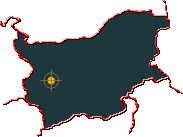 Name:
София (Sofia). This name first appeared during the 14th century. Before, the town was known as
Serdica, then as Sredets and eventually as Triaditsa.
The name Sofia derives from a church in the centre with the same name: Sv Sofia.
Name:
София (Sofia). This name first appeared during the 14th century. Before, the town was known as
Serdica, then as Sredets and eventually as Triaditsa.
The name Sofia derives from a church in the centre with the same name: Sv Sofia.
Location:
Sofia occupies a large plateau with an altitude of around 550 metres, which makes it one of the highest-located capitals of Europe
(not really a reason to visit, though). In the south, there's the massive →Vitosha mountain range and in the
north the Stara Planina (aka Balkan) mountain range. The mountains protect the city from cold winds. Sofia is halfway between the
Adriatic Sea and the Black Sea - a fact that highly influenced the development of the town. Once, when
→Macedonia was still part of the
Bulgarian Empire, Sofia was right in the middle of Bulgaria. Today, it's only some 50 km away from the border to
→Yugoslavia.
Population: around 1.2 million inhabitants. By all means Bulgaria's
biggest city.
Orientation:
It doesn't matter from where you enter the town - the first thing visitors will see are large housing areas with more or less
dull apartment blocks. They also dominate the vista when you look upon the town from the Vitosha mountains.
This view doesn't promise a very interesting place. Sofia's relatively small old city centre is surrounded by industrial areas and
those again are surrounded by large residential areas. Unfortunately, the old city centre suffered heavy air raids during the
World War II, so there's not so much left of it. Right in front of the train station starts the long and wide
бул. Мария Луиза
(Mariya Luiza Blvd) leading to the south of the city. East of the boulevard, between
ул. Сливница (ul. Slivnitsa)
and ул. Евтимий (ul Evtimii) (ul.=street),
stretches the historic centre with all the expensive shops, important churches, administration buildings and so on.
History:
Thracians founded a first small settlement near present-day Sofia around the 5th century BC. The location was perfect.
In Sofia, the historic trade routes between and
→Constantinople and →Belgrade and the route between
→Bucharest to Athens met. Around Sofia, there are some hot springs. The Thracian tribe
settling around the plateau called itself Serds, and so the town was named
Serdica.
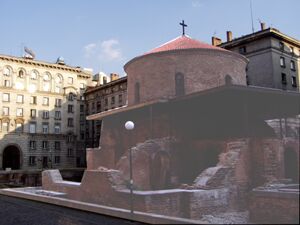
| |
Church of St George from Roman times (4th century)
|
After the 7th century, Slavic tribes gradually pushed out the Roman population. During the First Bulgarian Empire, after the year 809,
Sofia became one of the most important towns of the empire. At that time, it was called Sredets
(literally: the middle). Since 1018, Sredets was ruled by the Byzantines and renamed
Triaditsa (which means something like "triple town"). The name 'Sofia' was not used before the year 1328 during
the Second Bulgarian Empire. In 1393, the almost 500 year-long occupation by the Ottomans started. Sofia never gained much importance
during that time. After the liberation in the 19th century, Sofia only had around 20,000 inhabitants. Nevertheless it became capital
again in 1879, which naturally initiated a construction boom.
Due to the fact that Bulgaria was a pro-fascist country during the World War II, the town suffered massive air strikes.
After the end of war in Bulgaria, since 1944, some monumental Stalin-style buildings were erected in the centre in order to fill the gaps.
During the last decade, many things changed. Compared to the beginning of the 1990ies, Sofia has been given an impressive facelift
and can almost be called a beautiful city by now. Additionally, a subway line is under construction - definitely a good idea, since
the permanent heavy traffic inside the city is a huge problem.
Getting there:
Sofia's central bus station for long-distance busses is located between the main train station and
the distinctive Princess Hotel. From there it's a 15 minutes walk southwards along the Mariya Luiza blvd
to the centre of town. The international airport is only 12 km away from the centre in the east.
The city itself is best explored by bus and tram (a single ticket costs 0.4 Lv) and, probably in a few years, by subway.
For more information on how to get to Bulgaria see →Bulgaria travel information.
|
|
|
|
|
|
|
Nowadays the city makes for a pleasant stroll - this was different around and before 1990. The city centre is vibrant
and there's plenty to see around
пл. Света Неделя
(Holy Nedelya Square). Many new shops (among them excellent ice-cream parlours!), newly restored buildings,
a monument here and there and some interesting churches await the visitor. In the middle of the square, there's a church
with the same name (see picture), which was built in 1863. During the depression in the 1920ies in Bulgaria, in 1924 to be
exactly, there was an assassination attempt on the life of Tsar Boris III. The blast inside the church killed 124 people -
including almost all members of the Bulgarian cabinet. Of course, the Tsar was still alive and kicking.
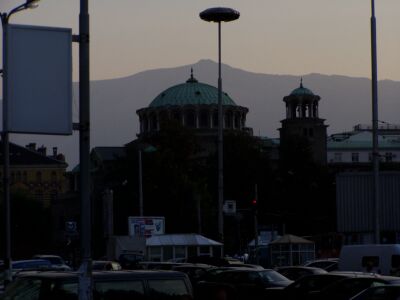
|
Church of St Nedelya in the evening
with the Vitosha mountains in the back
|
The church was rebuilt shortly after the incident. When walking along above-mentioned
бул. Мария Луиза
(Mariya Luiza Blvd) northwards for a few hundred metres only, you will come across a
strange junction. Almost in the middle of the junction, but one level below the street, there's a tiny church called
църква Света Петка
(church of Hl. Petka). This church was built in the 14th century during the Ottoman occupation, which explains its
unobtrusive appearance. Inside the church, some beautiful frescoes make the visit of the church a worthwile one. Bulgarians
know about that and so admission fee is 5 Leva - compared to other places in Bulgaria quite a lot. Within sight, there's the
so-called
Баня Баши джамия
(Banya Bashi mosque) one of Sofia's very few remaining mosques. The mosque is still in use today. 'Banya' means 'bath', - there was
one attached to the mosque, but it's not used any longer. Instead of the hamam, there are some drinking water taps behind the
mosque. Even today, the water taps are frequently visited by thirsty citizens. The mosque was built in the year 1576 (for a
picture of the church and the mosque see →History of Bulgaria.
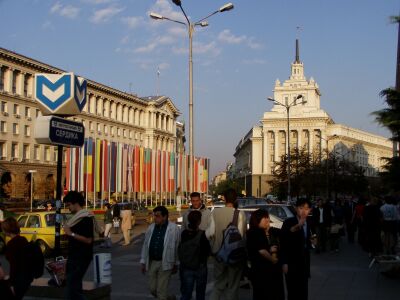
| |
The former headquarters of the Communist party
|
Turn east at Petka church and you will see a large square, surrounded by typical Stalinist-style monumental buildings,
resembling places like →Bucharest and other masterpieces of socialist architecture.
This short but wide square is well kept. The square is simply called
Ларго (Largo) and dominated by the large triangular building at the
back of the square, which was used as the headquarters of the Bulgarian Communist Party.
Halfway between Petka church and headquarters you can enter one of the large courtyards to your right.
Inside, there's a surprise:
The църква Свети
Георге (church of St. George (see picture on the top right).
This church was built in the 4th century, and so it's one of the oldest buildings of Sofia. The frescoes inside the church
are from a period between the 10th and 14th century. Next to the church, the remainings of an old public bath can be seen.
Walk right from the headquarters of the Communist Party and you will enter the
бул. Цар
Освободител
(boulevard of Tsar Osvoboditel (=Liberator)), which leads straight to the university. In the vicinity, there's also the
Bulgarian Parliament on the left and behind it the large
храм-паметник
Св. Александър
Невски (monumental church of St Aleksander Nevski).
This 60-metres high cathedral with it's 12 golden domes is considered one of the most beautiful churches in the Balkans.
The cathedral was completed in 1922, commemorating the estimated 200,000 Russian and Bulgarian soldiers,
who had lost their lives during the Russian-Ottoman war
(see also →History of Bulgaria). It took more than 40 years to
built the cathedral.
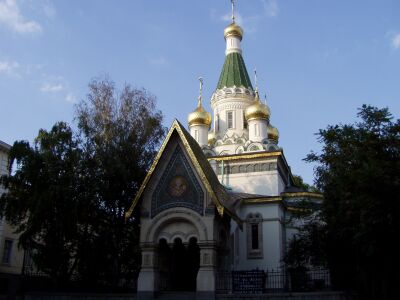
| |
The old Russian Church of St Nikolai
|
Right of the cathedral (when approaching from Largo) there's a permanent flea-market, where vendors sell art, coins, medals etc -
the perfect place for people looking for souvenirs.
Another interesting sight along blvd Tsar Osvoboditel is the
църква Свети
Николай (Russian church of St Nikolai), a small and neat,
typical Russian church, which was built in 1913 by order of the Russian consule. As a matter of fact, there's not a very big
difference between the Bulgarian-orthodox and the Russian-orthodox church, but still the consule wanted his own church.
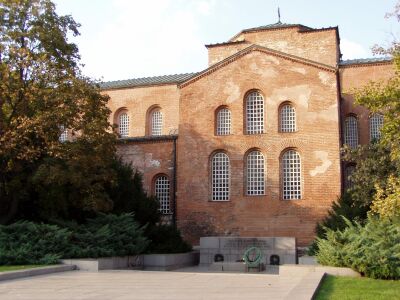
| |
Church of St. Sophia and the Tomb of the Unknown Soldier
|
Back to Nevski-cathedral: When you stand in front of the main entrance, you will see
църква Света
София (church of St Sophia) on your right. This church has given the
town its recent name. The word 'Sophia' derives from the Greek word 'σοφία = sophíā',
which means 'wisdom'.
Hence, Sophia is the 'wise one'. Large parts of the church are from the 6th century. In front of the church
(when seen from the cathedral) there's the Tomb of the Unknown Soldier - together with
the obligatory eternal flame.
Except for some interesting museums and galleries, sights in Sofia are limited to the above-mentioned places.
Still, the town is definitely worth a visit - also for travelers not being interested in churches. And - there's plenty to
see around the capital, so it makes a convenient base for day trips (see below).
|
|
|
|
|
|
|
Around 10 km south of the capital and easy to see on more or less clear days, there's the massive
Vitosha mountain range towering over the plateau. Vitosha can be called the lungs
of Sofia. A short description: The Vitosha mountain range is only 18 x 20 kilometres big and features 11 summits
higher than 2,000 metres. Among them 2,290 metre high
Черни Връх (Cherni Vrach) marks the highest
peak of the mountain range. Vitosha is a real blessing to the capital.
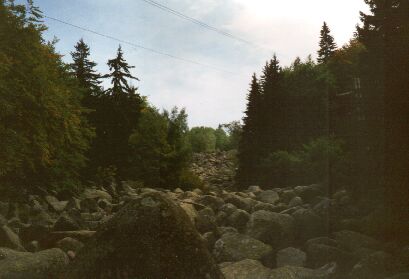
| |
Block field 'Golden Bridge' in the Vitosha mountains
|
There are even ski lifts and other winter sports facilities in the mountains. It takes around 30 minutes to
get from Sofia to the mountains by bus or car. One road leads straight into the mountain range. There's a
chairlift taking visitors almost to the top of the highest summit. The view from the top of the mountains
to the capital far below the mountains is just breathtaking. The entire mountain range is a so-called "peoples park" -
some kind of national park. Up to a certain altitude, almost all of the area is covered by forests. Hidden inside the
mountains, there's a place called Golden Bridge - a long stream of eroded granite blocks, as
it can be seen in some other mountainous areas as well.
Another day-trip and some kind of a must-see in Bulgaria is the worldwide famous →Rila monastery
south of the Vitosha mountains.
|
|
|
|
|
|
|
There's plenty of accommodation in Sofia: hotels, hostels, private accommodation etc. Some of the hotels concentrate
along the right side of Mariya-Luiza blvd (when coming from the train station) right behind blvd Slivnitsa
and the smelly canal called Vadaiska running parallel to the boulevard. One of the hotels there can be found in a small
lane and is called Hotel Enny. Rooms there are nice and clean, and there's a small beer garden
in the courtyard. All in all a neat and convenient place to stay. A double sets you back 40 Lv (€ 20).
It's between the train station and the centre of town, so everything is within walking distance.
By the way - when you walk out of the hotel, turn right and walk down the street to the end, you just need to walk left
for a few metres and you will see a small restaurant. It's a small and plain restaurant serving traditional Bulgarian
dishes for a few Leva only. The address of the hotel: Pop Bogomil 46, Tel.: 834395. Right around the corner there's the
Shenski Bazaar (Women's bazaar) - no, you can't auction women there, it's just a tiny bazaar.
There are also some hostels, hotels and mountain huts in the Vitosha mountains.
|
|
|
|
|
|
|
www.sofia.bg/en/index_en.asp:
Official website of Sofia. Here's the extensive English version.
www.virtualtourist.com/m/53910/5ca44/
A helpful website with plenty of information written by a Sofia citizen.
www.sofia.com/sightseeing/points.html
Description of all sights in Sofia in English.
Do you have or do you know a good website about Sofia? Don't hesitate, let me know!
After checking it, I would love to add it to the link list.
Please note that commercial websites will be declined. For e-mail link see menu on the left.
|
|
| |